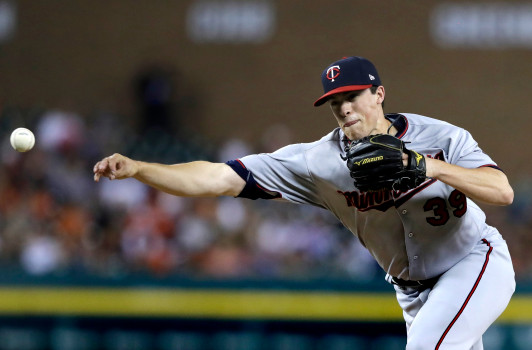Trevor Hildenberger: Twins RHP
1. Could you tell us your story on dropping down?
I dropped down in the summer of 2012 at the very end of my 3rd year at the University of California at Berkeley. It was the final week of the season before we all went off to summer ball and I was waiting to throw a midweek bullpen. The teammate ahead of me was wearing the wrong practice jersey because he had lost of his own. So my pitching coach Mike Neu recognized my teammate wearing the wrong number and made a comment about how he pictured a corner outfielder with that number and not a left handed pitcher. I then asked him what he pictured when he saw number 26? (which was my jersey number) He said that it reminded him of a sidearmer from UCLA, and a sidearmer from Washington that both wore #26. Recognizing a pattern, he asked me if I had ever tried throwing from that arm angle, and when I indicated no, we decided to try it out right then and there. It felt comfortable and easy, I was able to throw strikes. So from that moment forward, I was fully committed to pitching sidearm and went off to summer ball to go through some growing pains and try to learn my new arm angle.
2. What are some of the advantages you have from your arm angle?
I honestly believe that it is easier to throw strikes from my arm angle once I got the hang of it and found a consistent release point. I also think it's very hard to throw anything that stays straight from a sidearm release so my fastball has natural movement that came very organically after I dropped down. So even with less velocity, the movement down in the zone was able to create groundballs when I first started. Another advantage I have come to realize, is the fact that it puts less stress on my shoulder than throwing over the top. I had had some shoulder trouble before switching down and since that change in 2012, I have had no shoulder problems.
3. If you didn't drop down, do you think you would have had the same success?
There is no foreseeable way that I would have had the same success over the top that I have had sidearm. In my first 3 years of college, I had pitched 12 innings cumulatively, had around a 5 era, and was not pitching important innings. Switching to sidearm gave me the ability to throw strikes with a fastball with movement, and to throw multiple off speed pitches for strikes. That was never my strong suit when I pitched over the top.
I don't wish I would've dropped down sooner because I don't think I would have put in the same effort to make it work as I did when I was a junior. I think I had gotten to the end of my rope, and was willing to make any adjustments necessary to be competitive and to contribute to the team.
4. What would you tell someone debating on changing their arm angle?
I would tell anyone who is thinking about switching sidearm to consider it seriously, and to be absolutely positive that they are committed to it. I think some people can see it as a gimmick, or a trick, and not a true career adjustment. It takes a long time to get used to, and there will definitely be frustrations along the way, but it can take you a very long way when you start to find what works for you and how to have success. It can be a very rewarding process.
5. Are there any mechanical tips that you'd give to someone throwing sidearm/submarine?
As far as mechanics, everybody is different and needs to find out what works best for them; but I like to focus on my hips and my shoulders. If my hips are opening to soon, I know that the ball will sail armside because my arm is too far behind. When my arm begins too soon, before my front foot lands and my hips have a chance to fire, I know that my arm will be ahead of my body and fastball will tend to be gloveside. A lot of my power and my consistency come from my hips, so I would focus on them and try to find the body awareness to know when something is off, and an adjustment needs to be made.
6. What pitches do you throw?
Sidearm, I throw a 4 seam, a sinker, a slider, and a circle changeup.
4 seam: 89-92
sinker: 86-90
slider: 75-79
changeup: 72-78
Over the top which I still use from time to time I throw a fastball and changeup
4 seam: 91-95
changeup: 80-82
7. How do you pitch to lefties/righties?
The approach against righties and lefties changes so much depending on the batter and the situation. I don't think I can say for certain I have a blanket approach to either one. But speaking generally, I like to keep the ball down in the zone, and to mix all 3 pitches to both sides of the plate, trying to keep guys off balance.
8. What is your favorite part about pitching from down there?
My favorite part about throwing sidearm is that I bounce back faster than I used to when I threw over the top so I can throw more often which can be very valuable out of the pen. I also love throwing my changeup from down there because I think guys who see me for the first time assume I only have fastball and a frisbee slider so it can be fun to surprise people.





